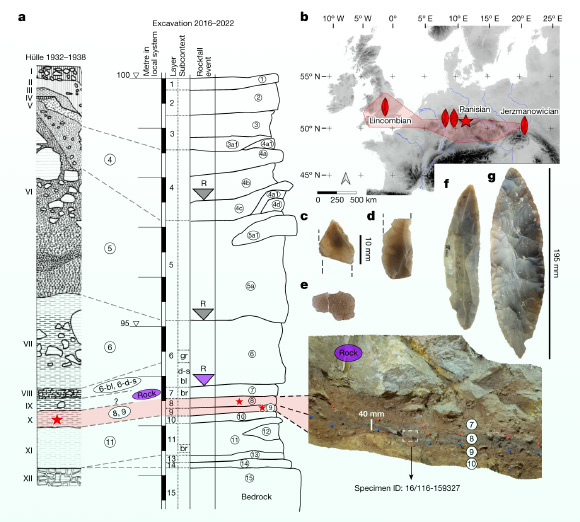Homo sapiens associated with the Lincombian-Ranisian-Jerzmanowician culture were present in central and northwestern Europe long before the extinction of Neanderthals in southwestern Europe, according to a trio of papers published in the journal Nature and the journal Nature Ecology & Evolution. The evidence that Homo sapiens and Neanderthals lived side by side is consistent with genomic evidence that the two species occasionally interbred. It also feeds the suspicion that the invasion of Europe and Asia by modern humans some 50,000 years ago helped drive Neanderthals to extinction.
The Paleolithic Lincombian-Ranisian-Jerzmanowician (LRJ) culture or technocomplex extends across northwestern and central Europe.
The Ranis cave site in the Orla River valley, Thuringia, Germany, is one of the eponymous LRJ sites based on its unique composition of bifacial and unifacial points.
Because of previous dating, the site was known to be 40,000 years old or older, but without recognizable bones to indicate who made the tools, it was unclear whether they were the product of Neanderthals or Homo sapiens.
“The new findings demonstrate that Homo sapiens made this technology, and that Homo sapiens were this far north at this time period, which is 45,000 years ago,” said Dr. Elena Zavala, a researcher at the University of California, Berkeley.
“So these are among the earliest Homo sapiens in Europe.”
“The Ranis cave site provides evidence for the first dispersal of Homo sapiens across the higher latitudes of Europe,” said Professor Jean-Jacque Hublin, a researcher at the Collège de France.
“It turns out that stone artifacts that were thought to be produced by Neanderthals were, in fact, part of the early Homo sapiens toolkit.”
“This fundamentally changes our previous knowledge about the period: Homo sapiens reached northwestern Europe long before Neanderthal disappearance in southwestern Europe.”
The scientists conducted the genetic analysis of hominid…
Read the full article here







